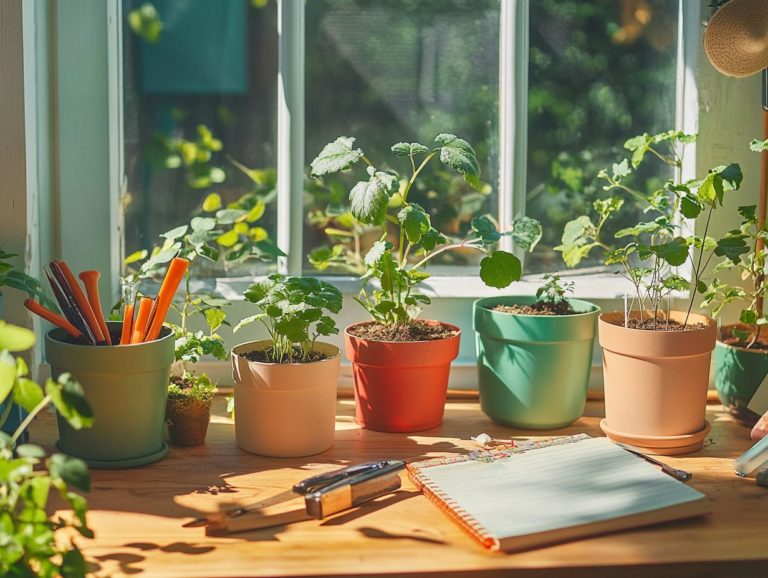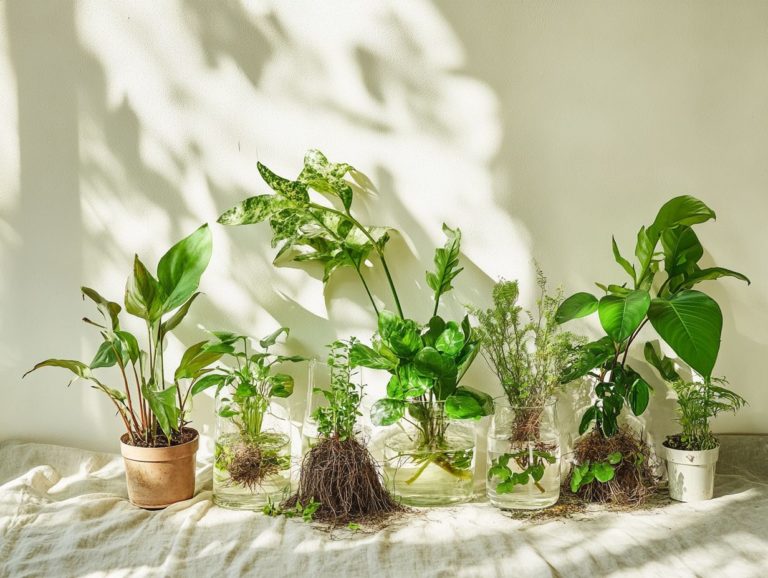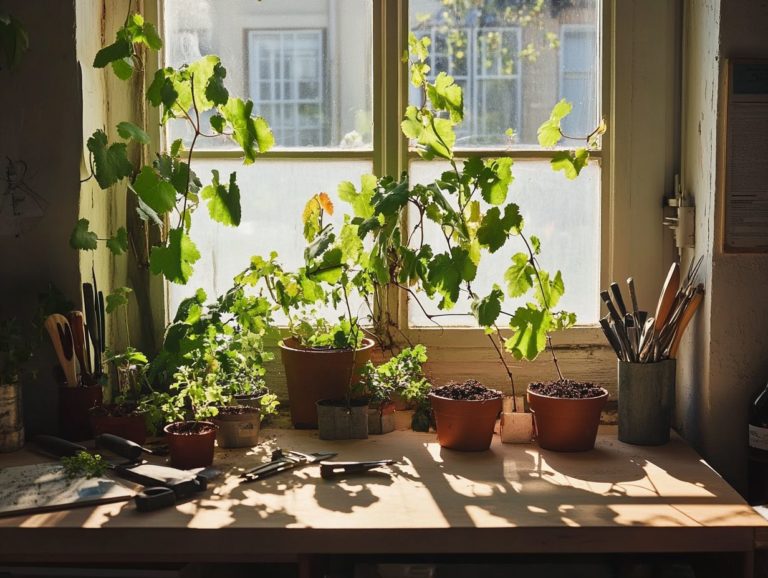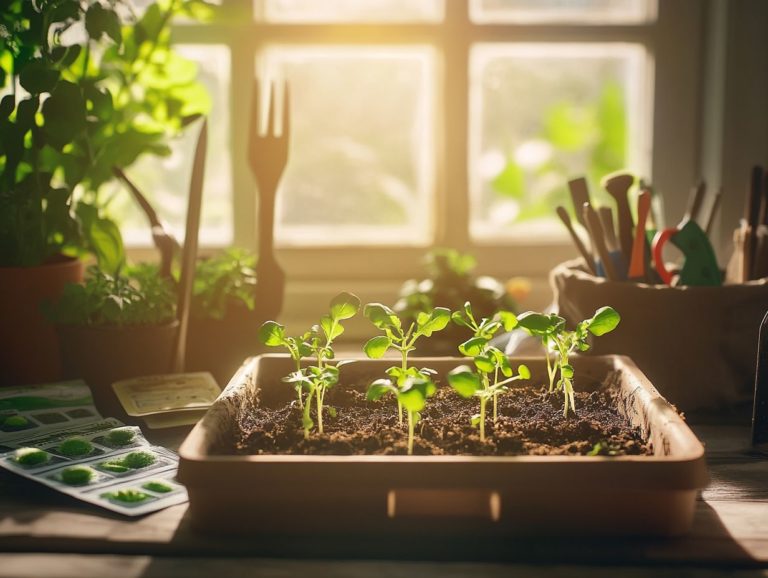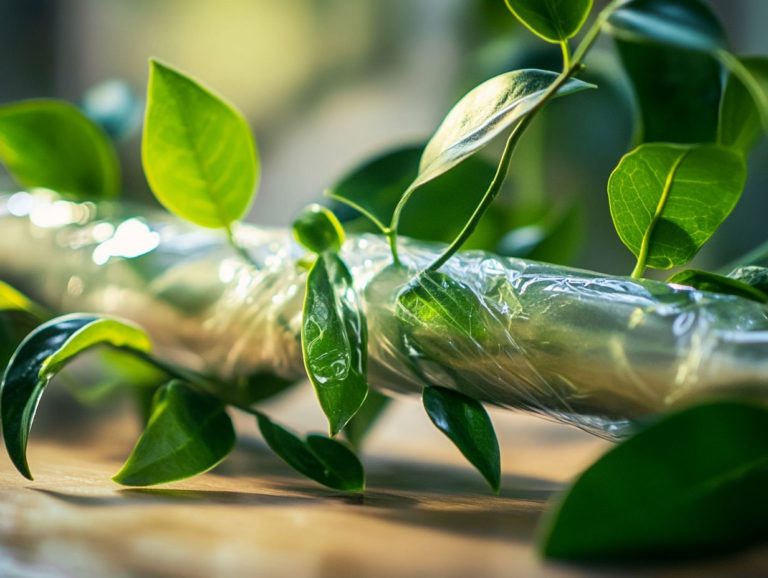Step-by-Step Guide to Leaf Cuttings
Leaf cuttings are an accessible and gratifying method of plant propagation.
Whether you’re a seasoned gardener or just starting, this technique allows you to clone your cherished plants effortlessly.
Delve into the different types of leaf cuttings.
Choose the best plants for propagation and learn how to care for them.
Prepare to nurture your green thumb. Expand your indoor oasis!
Contents
Key Takeaways:
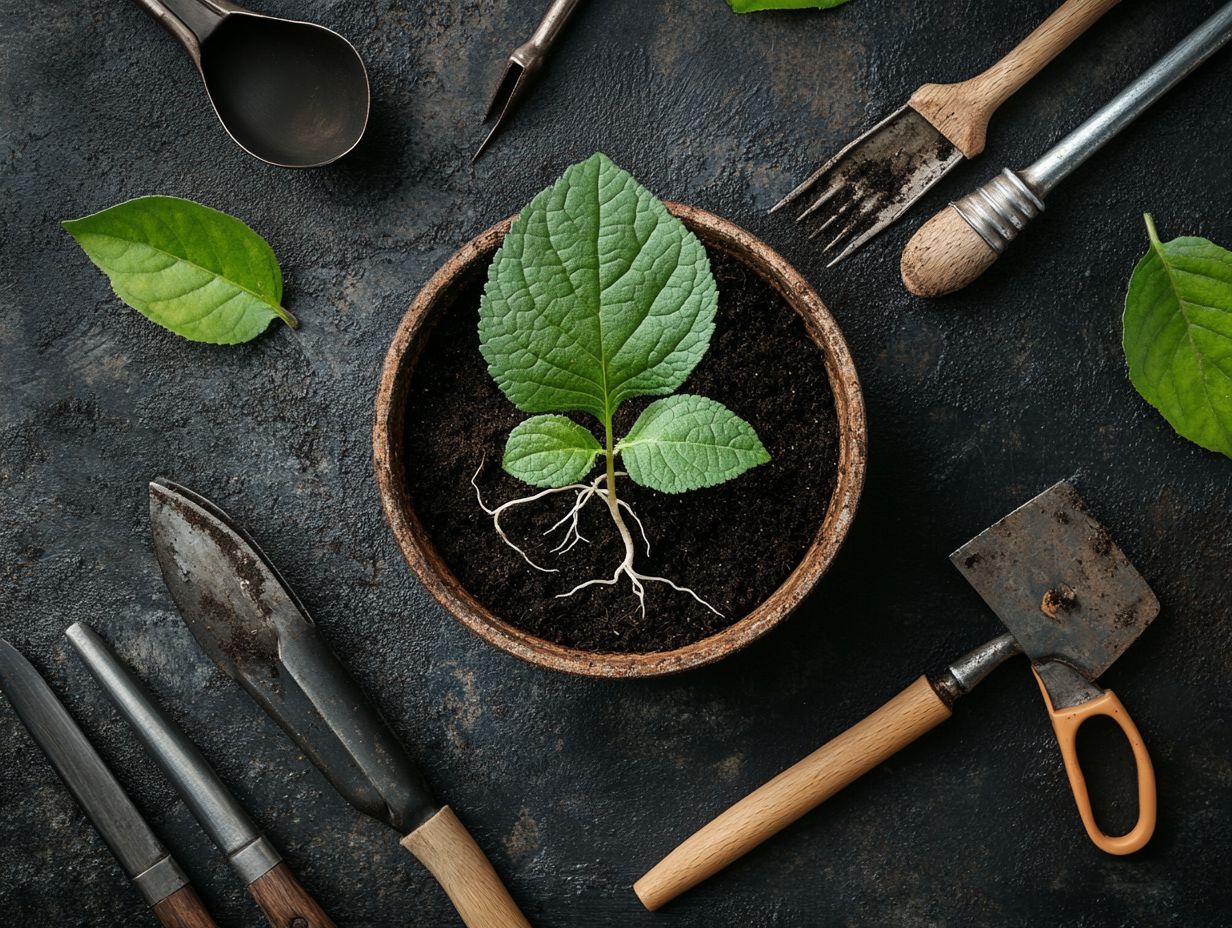
- Choose healthy leaves from the right plant for successful leaf cuttings.
- Proper preparation and environment are crucial for the success of leaf cuttings.
- Follow step-by-step instructions and care tips for successful propagation and maintenance of new plants.
What are Leaf Cuttings?
Leaf cuttings are a popular way to create new plants from existing ones. This method allows you to grow a variety of indoor plants easily.
By selecting healthy leaves and placing them in a nurturing environment, you can expand your plant collection while ensuring robust growth.
Utilizing leaf cuttings is especially significant for species like succulents, pothos, and African violets, which flourish through this method.
Choosing healthy, mature leaves is key; they enhance the chances of successful root formation and boost the overall vitality of the new plant.
Provide the right balance of humidity, light, and temperature to create an optimal environment for rooting. Your careful attention will help these plants thrive!
Types of Leaf Cuttings
There are different types of leaf cuttings suited for various plants.
These include softwood, semi-hardwood, and hardwood cuttings. Each type requires specific care based on the plant.
Softwood, Semi-hardwood, and Hardwood Cuttings
Softwood, semi-hardwood, and hardwood cuttings represent distinct stages of plant growth.
Softwood cuttings are typically easier to root, while semi-hardwood cuttings require a bit more care.
Hardwood cuttings might need a rooting hormone, which helps to stimulate root growth.
Understanding these differences is crucial for your gardening endeavors.
For example, softwood cuttings are often ideal for herbaceous plants like geraniums, as they root quickly in warm conditions.
Semi-hardwood cuttings, such as those from azaleas, thrive in a more regulated environment and may benefit from a misting system.
Hardwood cuttings, suitable for trees like willows, typically require a cold, moist environment to germinate. Selecting vigorous, disease-free stock boosts your success rates.
Choosing the Right Plant and Leaf
Choosing the right plant and leaf is key for successful propagation.
Go for varieties like Echeveria, Kalanchoe, and Peperomia they thrive with this method!
Always pick leaves that are healthy and free from disease to promote optimal growth.
The type of leaf you choose can greatly affect your success.
Best Plants for Leaf Cuttings
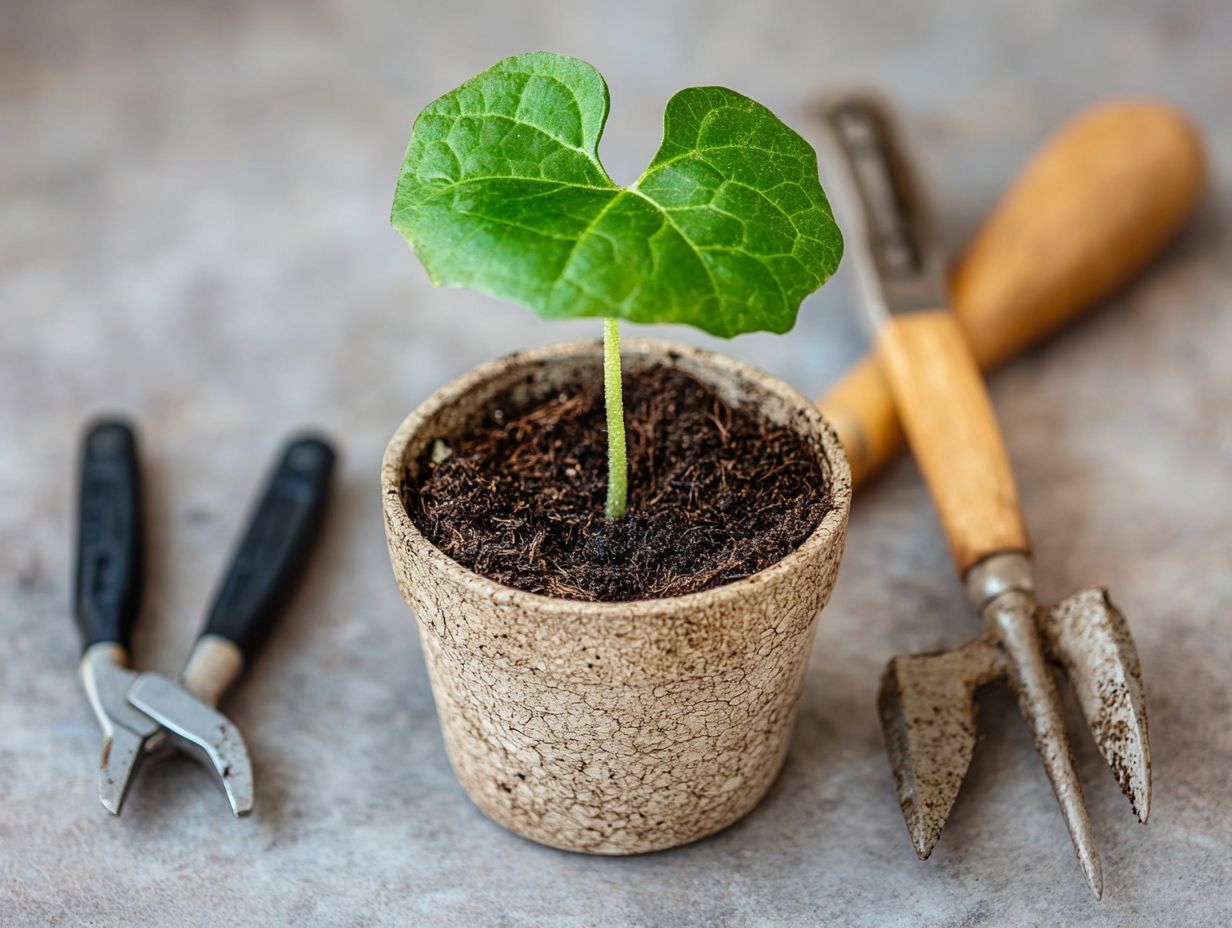
When you re looking to propagate plants through leaf cuttings, certain species like African violet, Begonia, and Crassula emerge as top contenders. They re known for their ability to root easily and flourish into strong, healthy plants. Not only do these varieties thrive indoors, but they also contribute lush foliage, making them perfect for anyone eager to elevate their plant collection through effective propagation techniques.
Each of these plants comes with unique traits and care needs, catering to both novice and seasoned gardeners. Take the African violet, for example; it thrives in bright, indirect light and prefers a well-draining potting mix. It requires consistent moisture without the risk of overwatering. Begonias enjoy a bit of humidity and cooler temperatures, flourishing in peat-based soil. Meanwhile, Crassula, with its succulent charm, asks for less frequent watering and a warm, bright atmosphere.
Understanding these nuances sets you up for successful rooting and ensures healthy growth and longevity for each plant. This allows you to create a lush green sanctuary within your home.
Identifying Healthy Leaves for Propagation
Identifying healthy leaves is crucial in your leaf-cutting journey. The success of propagation relies heavily on the quality of the materials you choose. Look for leaves that are healthy and free from blemishes, pests, or any signs of disease. Using unhealthy leaves can slow down rooting and stunt the growth of your new plants.
When inspecting potential cuttings, focus on those that boast a deep, consistent color and a firm texture. These traits indicate that they are well-hydrated and packed with nutrients. Avoid leaves that appear wilted or have dry edges, as these signs suggest stress or a lack of vitality.
For optimal results in propagation, take cuttings during the plant’s active growing season. Use clean, sharp tools to prevent any damage or disease transfer. Pay attention to environmental factors like humidity and light levels, as these can significantly boost your chances of successful rooting, ensuring that your newly propagated plants thrive beautifully.
Preparing for Leaf Cuttings
Preparing for leaf cuttings requires gathering the essential tools and materials needed for successful plant propagation. Creating a suitable environment for rooting and growth is key.
A balanced compost mixture a mix of soil, organic material, and nutrients is vital, paired with the right containers to house your cuttings. You might also consider using rooting hormone, a substance that helps plants grow roots faster, as it can significantly enhance the success of the process.
Ensure well-drained conditions to prevent rot and promote robust growth.
Tools and Materials Needed
Successful leaf cuttings demand specific tools and materials to guarantee effective propagation and promote healthy plant growth. For example, using sterilized cutting tools significantly reduces the risk of disease transmission, ensuring your cuttings remain healthy as they root.
A high-quality compost mixture rich in nutrients creates an optimal environment for new roots to establish while maintaining adequate moisture levels. In some cases, using rooting hormone can greatly enhance your chances of success, as it stimulates root development, particularly in more challenging species.
Using clear plastic bags or humidity domes helps maintain moisture and create a mini greenhouse effect, encouraging growth and increasing the likelihood of successful propagation.
Get ready to create your own indoor jungle! Start gathering your tools today and embark on your plant propagation journey!
Creating the Right Environment
Creating the right environment is essential for successfully rooting your leaf cuttings, as it directly influences their care and growth. Place your cuttings in a location with light shade, ensuring they bask in sufficient indirect sunlight while avoiding harsh conditions.
Be meticulous with your watering practices; maintaining moisture without oversaturation is key. Temperature plays a significant role in the rooting process, with an ideal range typically between 65 F and 75 F. This warmth encourages growth and root formation, giving your cuttings the best chance to thrive.
Pay attention to humidity levels, as slightly elevated moisture in the air can help prevent your cuttings from drying out. For optimal conditions, consider placing a plastic cover over the cuttings to create a mini greenhouse effect, which retains both moisture and warmth.
By adjusting these environmental factors as needed, you can significantly enhance the likelihood of rooting success and robust growth.
Step-by-Step Process for Leaf Cuttings
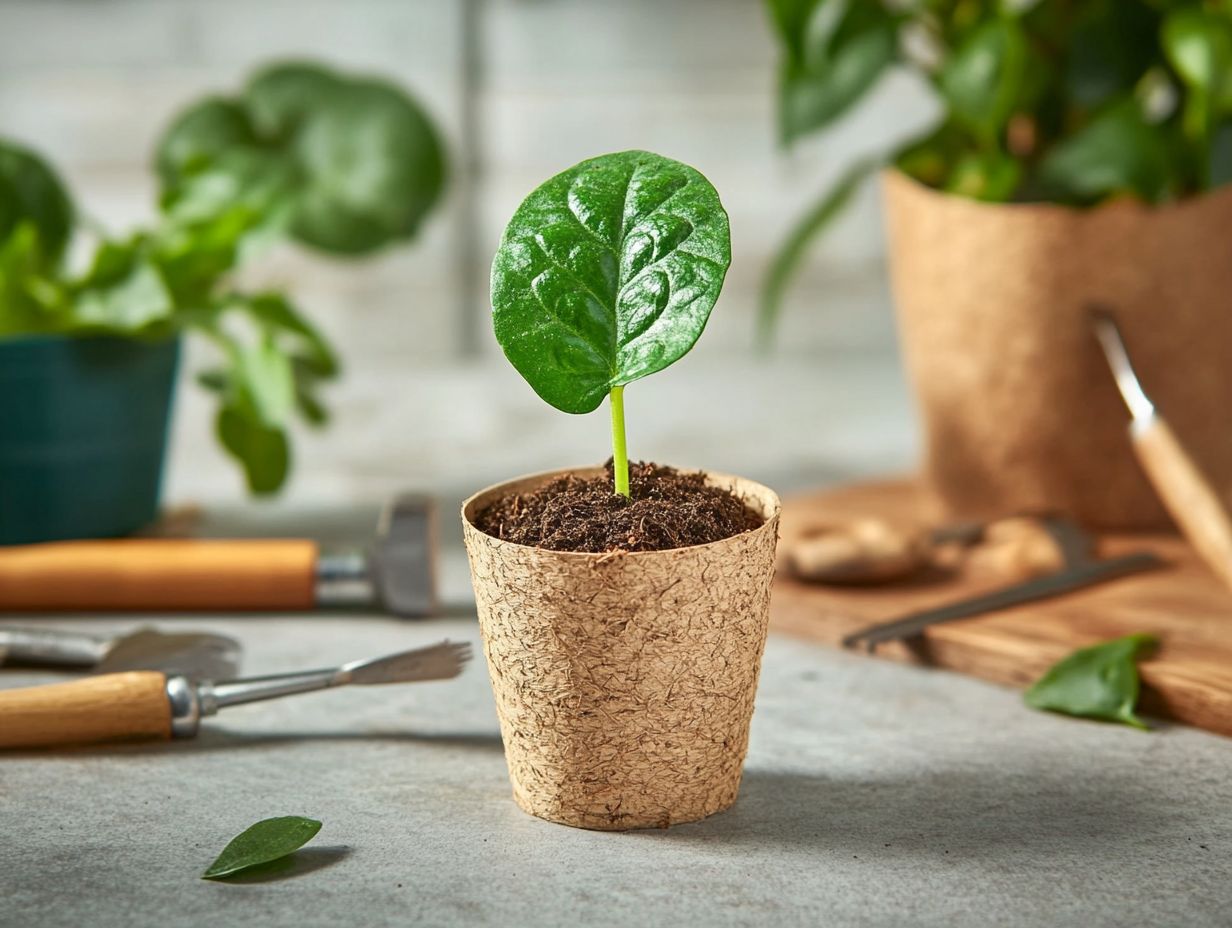
The step-by-step process for successful leaf cuttings involves several key actions that greatly increase your chances of effectively propagating plants.
- Start with healthy leaves they’re the foundation of your success!
- Consider using rooting hormone, a special powder that encourages roots to grow, when appropriate; it can give your cuttings that extra boost.
- Next, prepare the soil with a suitable compost mixture; each of these steps plays a pivotal role in ensuring a successful and vibrant cutting process.
Your attention to detail in these actions will significantly enhance your propagation efforts.
Detailed Instructions for Success
Following these detailed instructions will boost your chances of success! This involves mastering the proper cutting techniques, choosing an ideal medium for placement, and implementing careful watering practices to sustain optimal moisture levels during the rooting phase.
To start, selecting the right time of year for your cuttings is crucial; spring and early summer are often ideal, as plants are in their active growth phase. When making your cuts, remember to use a sharp, clean knife to prevent any damage or infection. After cutting, allow the leaf segments to callous over for a few hours this step promotes healing and reduces the risk of rot once you place them in the soil.
Using a well-draining potting mix can significantly enhance your chances of achieving healthy root development. In the initial weeks, provide indirect sunlight and avoid excessive watering, as too much moisture can lead to common pitfalls like fungal infections. Propagating in a humid environment can further boost your success rates, so consider utilizing terrariums or plastic covers to maintain necessary humidity levels.
Caring for Your New Plants
Caring for your newly propagated plants from leaf cuttings is essential for their thriving journey toward becoming robust specimens. This process requires meticulous transplanting into suitable containers, along with ongoing maintenance strategies that foster vitality.
By attending to their needs, you enable them to adapt seamlessly and flourish in their new environment.
Get started today on your journey to beautiful plants!
Transplanting and Maintenance Tips
Transplanting leaf cuttings into their permanent pots is a careful task that demands your full attention to detail to cultivate healthy, thriving plants. When you move your newly propagated plants, selecting a potting mix that offers both adequate drainage and essential nutrients is crucial. Couple this with attentive plant care practices, such as regularly monitoring their water and light needs, and you set the stage for growth.
This step is crucial for your plants to thrive, highlighting the importance of timing your transplant, typically when roots start to emerge. Understanding what each plant needs can significantly influence your transplant’s success; some plants flourish in slightly root-bound conditions, while others thrive with room to expand.
Post-transplanting, ongoing maintenance is essential. Establish a watering schedule tailored to each plant’s requirements and provide just the right amount of sunlight. Consistently checking for pests and diseases acts as a safeguard against potential setbacks, ensuring your garden is filled with vibrant, flourishing plants.
Frequently Asked Questions
What materials do I need for leaf cuttings?
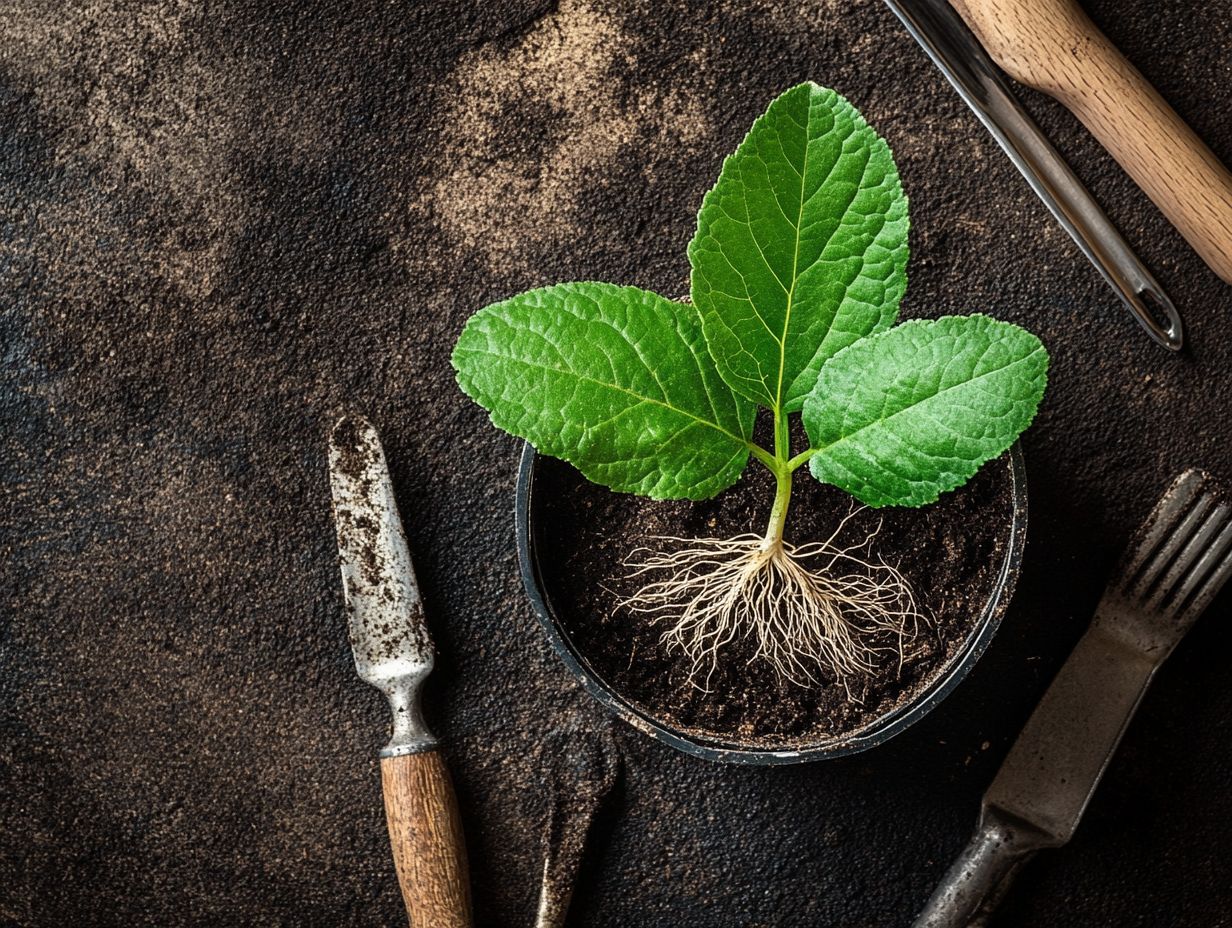
To propagate plants with leaf cuttings, you will need a sharp knife or scissors, a clean pot or container, well-draining potting mix, rooting hormone (optional), and a water mister.
How do I choose the right leaf for propagating?
Choose a healthy leaf from an established plant, ensuring it is free from any damage or disease. The leaf should also be mature and fully grown, with good color and a firm texture.
What is the best time of year to take leaf cuttings?
For the best results, take leaf cuttings in spring or early summer when your plant is growing strong. This is when the plant is actively producing new growth and will have a higher success rate for propagation.
How do I prepare the leaf for cutting?
Using a clean, sharp knife or scissors, carefully cut the leaf off the plant at the base where it meets the stem. Make sure to leave a small portion of the stem attached to the leaf, as this will help with rooting.
What is the ideal environment for leaf cuttings?
The ideal environment for leaf cuttings is warm and humid, with bright indirect light. You can create a mini greenhouse by covering the pot with a clear plastic bag or placing it in a clear container with a lid. This will help maintain the necessary humidity for successful rooting.
How long does it take for leaf cuttings to root?
The time it takes for leaf cuttings to root varies depending on the plant, but it typically takes 2-6 weeks. You can check for root development by gently tugging on the leaf. If there is resistance, it means roots have formed, and the cutting can be planted in soil.

